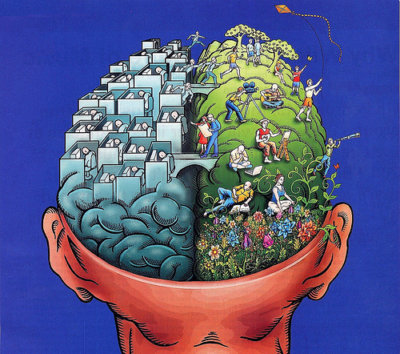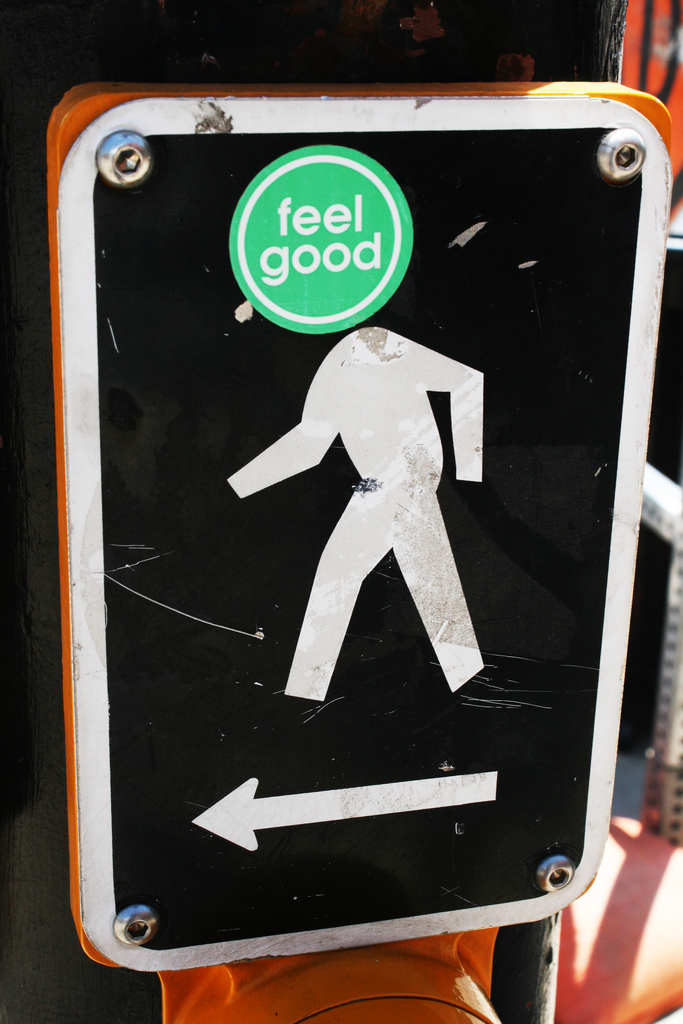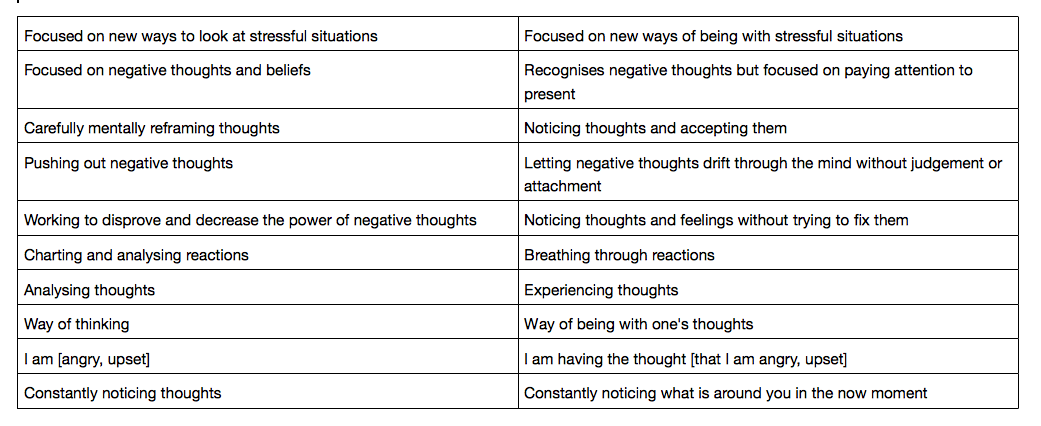By Harley Therapy January 16, 2014 Cognitive therapy, Counselling, Theory & training, Types of Therapy
 MBCT is a relative newcomer to the psychotherapy scene, and it can be confusing to understand the differences between it and CBT. First of all, what dpuo these acronyms stand for?
MBCT is a relative newcomer to the psychotherapy scene, and it can be confusing to understand the differences between it and CBT. First of all, what dpuo these acronyms stand for?
CBT= Cognitive Behavioural Therapy.
MBCT= Mindfulness Based Cognitive Therapy.
Does this imply that MBCT is just CBT with some meditation thrown in? Let’s take a look.
What is cbt?
Cognitive Behavioural Therapy (CBT) is a short- to medium-term talking therapy, with the client and therapist deciding on how many sessions will be involved- usually between six weeks and six months. The basic concept is that focussing on changing the way you think (cognition) will change the way you act (behaviour).
CBT looks at ‘negative spirals’ where your dysfunctional thoughts lead to feelings and physical sensations that then lead to actions. Changing these cycles means that anxiety and mild depression become more manageable. So CBT sets out to help you manage your problems in a more positive way by identifying and changing unhelpful thinking patterns.
A simplified example of CBT in action would be looking at the way you act when a friend says they can’t go out with you because they are busy. You might think they actually don’t like you and that’s the real reason they always say no to you lately, which leads to the more negative thought that ‘people almost never like me’, which leads to you feeling sad and a bit tired and paranoid or anxious. The result is you don’t go out at all and spend another Friday night in feeling bad about yourself.
CBT would encourage you to not accept this negative thought pattern, but to look at the ways your friend really might be busy, and to then identify the people who do like you. The idea is to question all negative assumptions. You might remember that the last time you went out with your colleagues from the office everyone said they enjoyed your company. This might make you feel more energetic, so you call up a workmate and go out with them, or bravely go to an open social gathering and meet new friends entirely. So by changing your thought to one of possibilities, you changed your feelings and physical energy for the better, and this changed your actions and thus your mood.
CBT aims to help you begin to think in open-minded over negative thought loops more and more, until it becomes habitual to think with a wider and more positive perspective over always thinking the worst, or always indulging in the extremes of ‘black and white thinking’.
What is mindfulness?
Mindfulness is a mental state and therapeutic technique attained by purposefully focusing your awareness on the present moment, while calmly and without judgement acknowledging your feelings, thoughts, and bodily sensations.
 The concept of mindfulness is quite ancient, and part of Buddhist and other Eastern spiritual teachings which believe that a calm awareness of one’s body, feelings, and mind is an important part of the road to self actualisation.
The concept of mindfulness is quite ancient, and part of Buddhist and other Eastern spiritual teachings which believe that a calm awareness of one’s body, feelings, and mind is an important part of the road to self actualisation.
Mindfulness was taken and developed in the 1970s as a psychological tool to manage anxiety, stress and chronic pain by Dr. Jon Kabat-Zinn, who then set up a Stress Reduction Clinic at the University of Massachusetts Medical School to teach its principles. Now mindfulness is a scientifically researched phenomenon recognised by the world’s leading doctors, scientists, and psychologists. In the 1990s it was further developed specifically to help depression.
Mindfulness has proved itself so useful as it helps combat the ‘auto-pilot’ it is so easy to live a busy modern life from. We eat an entire bag of pretzels without realising it until we reach into the bag and find it empty, or walk all the way to a destination before realising we haven’t noticed a single thing we’ve walked by. Why does this matter when it comes to depression? If we live our life in a spaced out way we are living life with our unconscious running the show, which leaves room for anxiety to take over.
And if we are distracted, challenges can take us unawares and we respond reactively, flying off the handle or saying something we regret. If we have present moment awareness we can be calmer and respond with consideration. Mindfulness helps us consider our actions and respond in thoughtful ways. And it helps us consciously choose what environments, people, and thoughts to be affected by, too.
In summary mindfulness creates room for us to make clearer choices, feel more in control of our lives, be calmer and make healthy decisions, and ultimately find more joy by noticing the positive details of our lives and relationships.
So let’s add them together- what is mbct?

By: Allan Ajifo
Mindfulness Based Cognitive Therapy (MBCT) combines the best aspects from both the above theories…and then some.
In the 1990s research by psychologists Jon Teasdale and Philip Barnard found the mind had two main modes, the ‘doing’ mode and the ‘being’ mode. The ‘doing’ mode is goal oriented, triggered when the mind sees a difference between how things are and how it wants things to be. The ‘being’ mode isn’t focused on achieving specific goals but rather accepting and allowing what is.
It was discovered that the ‘being’ mode was the one that lead to lasting emotional changes. So they concluded that effective cognitive therapy would have to promote not just cognitive awareness like CBT, but also the ‘being’ mode of the mind, such as mindfulness offered.
Psychiatrists Zindel Segal and Mark Williams as well as Jon Kabat-Zinn became involved and helped combine these new ideas about cognitive therapy with Kabat-Zinn’s mindfulness-based stress reduction program. MBCT was born.
Like CBT, the goal is to develop consistent awareness of your thoughts and reactions so you notice when you are becoming triggered into negativity. But MBCT teaches that the best way to notice these triggers and to manage stress and anxiety is to develop ongoing awareness and acceptance of the present moment. Instead of trying too hard to understand the thought, MBCT would promote accepting the thought without judgement and letting it drift from your mind without attaching too much meaning to it.
The greater and more consistent your awareness of the present moment, the more likely it is you will catch the negative thought spirals and choose to disengage from distressing moods or worries.
So then how exactly are cbt and mbct different?
CBT helps you recognise and reframe the negative thought patterns that lead to anxiety and depression.
To reiterate, MBCT also helps you recognise negative thoughts, and, like CBT, to learn that thoughts are not facts but something you can take a wider view of. But MBCT then uses mindfulness – recognising what is going on for you in the present moment, how you are thinking and feeling and experiencing things right now – to help you be less caught up in mental loops in the first place.
CBT uses cognition to understand negative thought processes. In other words it’s a ‘thinking’ therapy. It is analytical, with clients tasked with charting their emotions and reactions as homework. Although it does take note of the body’s reaction to stress and negative thoughts, it could be called a ‘head-based’ therapy. The focus is on mentally ‘pushing out’ negative thoughts.
 The tools used in a series of MBCT sessions are quite different, and might integrate things like breath focus (where you spent a few minutes putting your attention on your breathing), body scans (observing the tension and sensations in the body) and sitting meditation. In this way, it can be a ‘feeling’ process. It can be seen as experiential, not just analytical, and although it still involves a lot of work with recognising thought patterns it is much more ‘body-based’ than CBT. The focus is on accepting thoughts as they arise, and letting them go.
The tools used in a series of MBCT sessions are quite different, and might integrate things like breath focus (where you spent a few minutes putting your attention on your breathing), body scans (observing the tension and sensations in the body) and sitting meditation. In this way, it can be a ‘feeling’ process. It can be seen as experiential, not just analytical, and although it still involves a lot of work with recognising thought patterns it is much more ‘body-based’ than CBT. The focus is on accepting thoughts as they arise, and letting them go.How are cbt and mbct the same?
As mentioned, they both work to help you recognise and change negative thought patterns and help you control your thoughts and therefore your moods. They both aim to make you less likely to be drawn into automatic reactions to thoughts, feelings and events.
They are also both short- to medium-term therapies. And they both work best with mild depression and anxiety over being the sole therapy for issues like trauma and abuse that might better suit a longer-term talking therapy.
Note, though, both these forms of therapy can be beneficial if used after successful treatment of a talking therapy, with MBCT in particular being useful to help clients who have dealt with long term depression and need a way to manage ongoing mild depressive episodes. It’s been proven that even after therapy the link in your brain between negative thoughts and negative moods still exists and is ready to be reactivated. So being able to monitor and contain reactivation, which mindfulness aids with, is invaluable.
Cbt vs mbct a quick guide
CBT MBCT
Conclusion
Both CBT and MBCT have been proven in studies to be effective ways of treating depression, and if you are choosing between the two it is really a personal choice. If you are not sure which type of therapy would suit you best you could always try to source a therapist who offers both options. And keep in mind when choosing a therapist that it’s not just the type of therapy that matters, but that sometimes what’s even more important is that the therapist is someone you feel you can connect and work with.
Has this article been helpful to you? Have something you’d like to add to the conversation, or a question you’d like to ask? Use the comment box below, we love hearing from you.






No comments:
Post a Comment